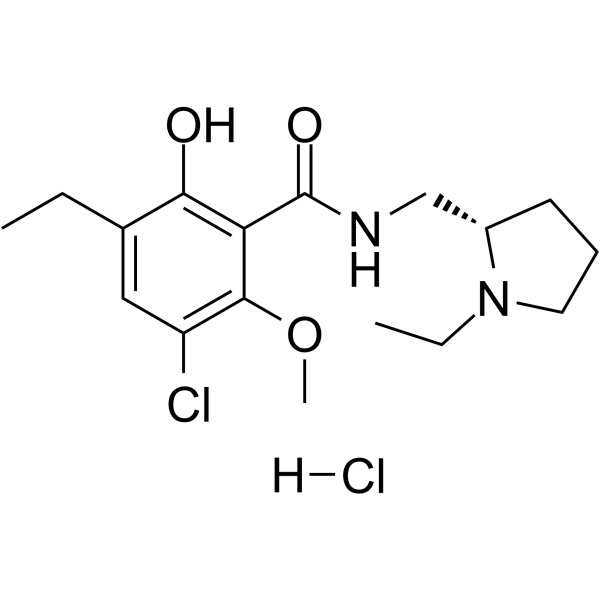Regional in vivo binding of the substituted benzamide [3H]eticlopride in the rat brain: evidence for selective labelling of dopamine receptors.
C Köhler, H Hall, L Gawell
Index: Eur. J. Pharmacol. 120 , 217-226, (1986)
Full Text: HTML
Abstract
The novel substituted benzamide eticlopride, (S)-(-)-5-chloro-3-ethyl-N-[(1-ethyl-2-pyrrolidinyl)methyl]-6-methoxy salicylamide hydrochloride (A38503; FLB 131), was radiolabelled to high specific activity and used for in vivo receptor binding studies in the rat brain. Intravenous injections of [3H]eticlopride resulted in a rapid accumulation of radioactivity in several brain regions: striatum greater than olfactory tubercle greater than septum greater than substantia nigra greater than frontal cortex greater than cerebellum. Approximately 95% of the radioactivity recovered from the striatum was in the form of authentic eticlopride, as determined by thin-layer chromatography. Two hours after injection, the ratio between the amount of radioactivity present in the striatum and in the cerebellum was approximately 10:1. The in vivo binding of [3H]eticlopride was saturable in all dopamine-rich areas, with a very low proportion of non-specific binding. The specific in vivo binding of [3H]eticlopride was blocked by several dopamine antagonists, including haloperidol, (+)-butaclamol, spiperone, d,l-sulpiride and remoxipride. The dopamine agonist N-n-propylnorapomorphine, but not apomorphine, was found to be a potent blocker of in vivo [3H]eticlopride binding. Serotonin and noradrenaline receptor antagonists did not prevent the in vivo binding of [3H]eticlopride. Autoradiographic analysis of the in vivo [3H]eticlopride binding showed a high density of binding sites in the striatum, nucleus accumbens and the olfactory tubercle. Moderate binding was found in the hippocampal formation and in the entorhinal area, but little or no binding was detected in other cortical regions. [3H]Eticlopride binding in all these areas was blocked by pretreatment with (+)-butaclamol. Taken together, these findings show that the substituted benzamide compound [3H]eticlopride passes readily into the brain and binds with high specificity to dopamine or neuroleptic receptors in dopamine-rich brain areas. Thus, eticlopride may be a useful tool in studies of dopamine D-2 receptors in vivo.
Related Compounds
| Structure | Name/CAS No. | Molecular Formula | Articles |
|---|---|---|---|
 |
FLB 131
CAS:97612-24-3 |
C17H26Cl2N2O3 |
|
Dopamine D2 receptor activity modulates Akt signaling and al...
2011-04-06 [J. Neurosci. 31 , 5512-25, (2011)] |
|
Dopamine D2 receptors are involved in the regulation of Fyn ...
2016-04-01 [J. Neurosci. Res. 94 , 329-38, (2016)] |
|
Some in vitro receptor binding properties of [3H]eticlopride...
1985-05-08 [Eur. J. Pharmacol. 111 , 191-199, (1985)] |
|
Dopamine regulates angiogenesis in normal dermal wound tissu...
2011-01-01 [PLoS ONE 6(9) , e25215, (2011)] |